
Although Thermal cutoff has high reliability in design, there are limits to the abnormal conditions that a single Thermal cutoff can cope with. In addition, due to man-made or unpredictable force majeure, the Thermal cutoff is damaged and cannot function normally, so the circuit cannot be cut off in time when the machine is abnormal. Therefore, when the machine is overheated, when the wrong action has a direct impact on the human body, when there is no circuit cut-off equipment except the fuse, and when high safety is required, more than two Thermal cutoff with different fusing temperatures should be used.
The thin Thermal cutoff is specially developed for the over temperature protection of lithium ion batteries. Its working principle is the same as that of the second Thermal cutoff mentioned above. The circuit is connected with low melting point alloy, which is wrapped with flux resin, connected with metal guide plate and sealed with plastic material. When there is a short circuit inside or outside the battery or other reasons cause the internal temperature of the battery to rise to a certain level, the Thermal cutoff close to the battery cell will quickly blow, thus cutting off the external circuit of the battery to prevent battery explosion and personal injury. As handheld electronic equipment needs to be more and more portable, the size of Thermal cutoff needs to be smaller and thinner. At present, the thinnest Thermal cutoff can be 0.65mm thick and 2.7mm wide. The internal resistance of the Thermal cutoff is also very small, only about 8m Ω. The power consumption in standby mode is very small, which can greatly increase the standby time of the lithium-ion battery.
It also has certain drawbacks. Firstly, it is not recoverable and is not as good as PTC. Even if an accidental fault causes PTC to act, once the fault is resolved, the battery can still continue to operate. Once the Thermal cutoff acts, the whole battery can no longer work. Of course, as the quality of the lithium-ion battery gets better and better, the probability of this kind of accidental failure becomes smaller and smaller. Once there is an exception, the battery will not be able to continue to use, but it has become the advantage of Thermal cutoff. After all, the cost of a battery is negligible compared to personal injury incidents. As the saying goes, it is better to kill by mistake than to let go. As long as the phone battery has experienced a high-temperature malfunction, who dares to leave this potential bomb by their side? Secondly, it cannot be welded and processed in ordinary ways, such as PPTC, which can withstand high temperature for a short time, so it can be welded in a reflow furnace and directly injected into the battery. However, the Thermal cutoff can only be locally welded by spot welding, Laser beam welding, etc. to prevent the Thermal cutoff from blowing.
At present, 98 ℃ and 92 ℃ thin Thermal cutoff are mostly used. At the heating rate of 1 ℃/minute, the fusing temperature of 98 ℃ thin Thermal cutoff is 94 ± 3, and the fusing temperature of 92 ℃ thin Thermal cutoff is 89+3/-4, that is, 85 ℃~92 ℃. At present, domestic manufacturers are developing thinner Thermal cutoff with higher fusing temperature.
Read recommendations:
slow blow fuse vs fast blow fuse.The difference and function of fuses and relays
fast blow fuse characteristics.What is the working principle of a fuse?